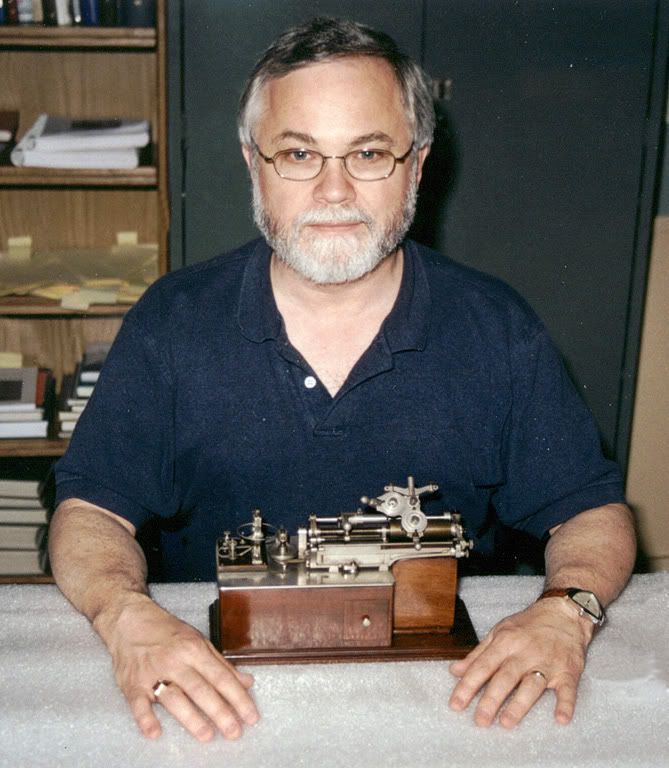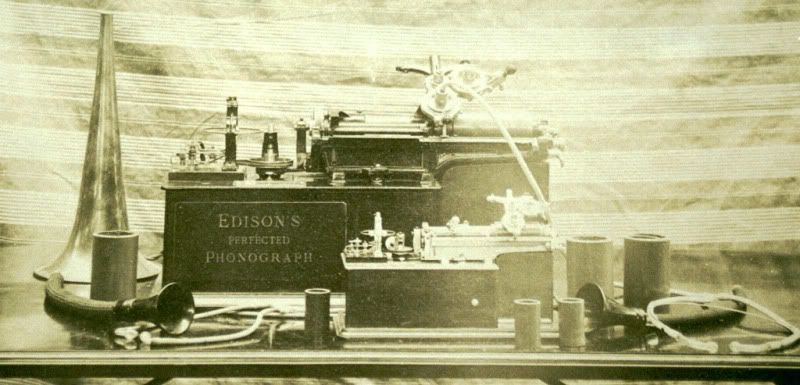That is an absolutely incredible find and I am very envious! At the same time, it is tremendously inspiring that so many amazing rarities still turn up. I seriously believed 30 years ago that all the good finds had been made, all the cellars and attics raided. Boy, was I wrong on that score! Your nickel Class M opens up a fascinating mystery to research and I'm glad you are pursuing it so seriously.
As a sidebar to this story, I cringe every time I see the term "
Military" repeated in reference to the ⅓ scale miniature Class M in the collections of the Edison National Historic Site.
Back in 2001-2004 when the late Bill Ptacek and I were doing serious research on this machine we were particularly perplexed by that "
military" designation. It really made no sense, given that a miniature phonograph -- with inconvenient battery power no less -- was in no way suited for any
military purpose we could fathom. Not to mention one very critical issue: the recording and reproducing diaphragms are so small in diameter that they would have virtually no flexibility, and with tiny stylii and short tracks on tiny records would not be capable of making a decent recording even under the best of circumstances, let alone on a battlefield. Frankly, we seriously doubted it could work at all. Check out how tiny it really is:

As I started digging in various sources I was unable to find a single reference to the term "
military" in any book, article, or other reference -- with one sole exception: George Frow's book on cylinder phonographs. But Frow cited no source for his use of the term.
In 2002 I made a phone call to Frow to ask about it. He was very old at the time and in the early stages of dementia, unfortunately. He had no recollection of where the '
military' designation came from, nor did he have any notes left that he could refer to.
I also posed the question to Paul Israel (Edison Papers Project), Ray Wile (noted researcher), and Ron Dethlefson (Edison expert and long-time volunteer at the Ford Museum). None had ever seen it referenced elsewhere. Paul Israel told me "As to the small "
military" form of the Class M phonograph, I don't know anything about that particular machine other than what Frow has written about it. He appears to get his information about this machine from J. Lewis Young,
Edison and His Phonograph (1890). I do agree that it seems unlikely that such a machine was actually intended for
military use." I checked the book in question but while J. Lewis Young referred to it as "portable," he makes no mention of "
military."
The only other contemporary reference I found was one referring to Edison carrying it under his arm as he boarded a ship to take to the 1889 Paris Exposition Universelle, but nothing mentioned or even implied a
military reference.
I asked Jerry Fabris at the Edison Site whether there was anything in their files to substantiate the "
military" designation. He replied that "I checked the catalog record, the catalog folder, and the original accession inventory here. There is no mention of the name "
Military" in any of those sources."
The earliest known use of the term "
military" remains Frow's 1978 edition.
Based on my research, and Bill's very intense study of the actual machine, as well as full-size Spectacle model Class Ms, we came to the inescapable conclusion that Frow's "
military" appellation was his own fabrication. Everything about the surviving artifact itself, as well as the limited documentary record, would seem to indicate that it was made strictly as a display piece for the Paris Exposition -- where it was prominently shown and appears in many contemporary photographs, such as this one:

It is certainly an impressive piece of work that would have been admired by anyone with an understanding of the complexity of building such a miniature working phonograph. If it had any intended purpose whatsoever, other than a one-time public display, it would seem logical that there would be some reference to that, somewhere. It is far too detailed and finely finished to be a prototype, and given that it is exactly the same as a conventional phonograph, except in ⅓ scale, means there is nothing about it that was new or experimental. Its size was its only novelty, and evidently its only purpose as well. The fact that it never had any apparent useful purpose, and evidently went straight from Paris into Edison's home, makes it seem all the more certain that it was a decorative display item than a working phonograph or experimental machine of any kind. (It was displayed in a dark cabinet in a corner of Edison's dining room until the recent rebuilding of the Edison lab, where it is now publicly displayed for the first time in decades.)
I think it's unfortunate that Frow's unsupported designation has now been reprinted so often that it has become "fact." I really winced when I found it was on the new explanatory sign at the Site since that essentially certifies the name officially.
I had originally intended to write an article about the machine but unfortunately I set it aside when Bill died, and with him the project to replicate the machine. I still have piles of notes filed away somewhere. Bill and I had many hours of discussion about the "
military" term, and we shared an absolute conviction that it's a total misnomer invented by George Frow, for no imaginable reason.
If anyone is aware of any contemporary citation that I have not found, I'd certainly love to know about it!
In the interim it is my hope that eventually we can eliminate this misnomer once and for all, just as researchers have finally done with the long-repeated but erroneous claim that the first tinfoil phonograph was completed in August 1877, rather than December. It took years to correct that flagrant mistake, this one may take even longer to overcome.

![[The Talking Machine Forum - For All Antique Phonographs & Recordings]](/styles/we_universal/theme/images/the_talking_machine_forum.png)


